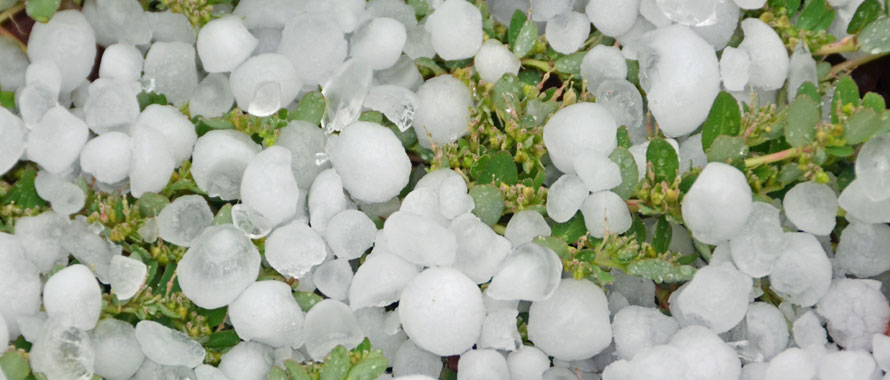Inside This Article:
- Hailstorms are a growing threat in the U.S. and Canada, causing more frequent and severe losses for homeowners.
- One record-breaking hailstorm in Calgary generated 130,000 claims and nearly $2.8 billion in losses.
- Property damage caused by hail can be covered by Homeowners Insurance, but separate wind and hail deductibles typically apply.
- Percentage-based deductibles and roof settlement schedules are on the rise.
- Homeowners are encouraged to take steps to safeguard their property and utilize building materials built to withstand hail damage.
Hailstorms are becoming more frequent, destructive and widespread, prompting some experts to describe them as the biggest climate concern in the insurance industry, Business Insider recently reported. Hail damage claims have been “eroding balance sheets” for 10 years, one expert told the publication, leading to rising premiums and more limited coverage.
In St. Louis, Missouri, in mid-March, a storm system that included tornadoes, thunderstorms, hail and heavy rain left widespread destruction, including “intense” hail damage to siding, Fox 2 Now reported. A recent storm in Daviess County, Kentucky, produced golf ball-sized hail that damaged roofs, siding, and vehicles, and hail up to 2″ in diameter recently fell in the Ohio Valley region.
Hailstorms are also occurring more often in areas that were historically less affected by hail, said Brandon McCarty, Midwest Regional Practice Group Leader, Personal Insurance, Burns & Wilcox, Philadelphia, Pennsylvania.
“Where we used to get hailstorms in the Midwest has slowly expanded outwards and upwards,” he said. “I am here on the East Coast, and we have gotten more hailstorms over the last three or four years than I can remember my entire childhood.”
It is a pressing concern in the insurance industry, where Homeowners Insurance policies today can no longer offer the same competitive wind deductibles and full replacement cost coverage on roofs as they have in the past, said Ethan Buske, Underwriter, Personal Insurance, Burns & Wilcox, Indianapolis, Indiana.
“That has severely shifted because of the size and the frequency of these convective storms,” he said. “Hail is the leading factor in that, along with wind.”
How hail risks have evolved
The rising threat of hail is also affecting homeowners in Canada, especially after an “unprecedented” hailstorm in August 2024 in Calgary, Alberta, that generated 130,000 claims totaling almost $2.8 billion in insured losses — a new record for hail losses in the country, the Calgary Herald reported.
“The hail stones were larger than golf balls and there was extensive damage to homes, vehicles and infrastructure,” said Michelle Allemang, Manager, British Columbia, National Product Leader, Personal Insurance, Burns & Wilcox, Vancouver, British Columbia. “It definitely captured a lot of attention, and we are starting to see an impact on the insurance market following that as well.”
As climate change continues to affect weather patterns, experts believe some regions will see an increase in hailstorms and more damaging hail, Scientific American reported in 2023. This is due in part to an unstable atmosphere, abundant atmospheric moisture, and strong updrafts, which are involved in hailstone formation, the publication noted.
A longer tornado season also heightens the risk for homeowners, McCarty said. “It used to be a couple weeks in April and May, but now we are talking about March into June,” he said. “The storm area is expanding, the timeline of when these are happening is getting larger, and the effects of the storms themselves are bigger and badder.”
The storm area is expanding, the timeline of when these are happening is getting larger, and the effects of the storms themselves are bigger and badder.
The potential damage caused by hail is often underestimated, McCarty said. “Hail can total cars, ruin your roof, break windows and destroy your siding. Even the smaller hail chips can still break windows and siding,” he said. “Individuals have even been severely injured by hail.”
Homeowners “definitely underestimate the risk and maybe have not thought about this as much in the past,” Buske agreed.
The “tennis ball-sized” hail often described in news headlines “is no joke,” Allemang added. “That reference is real,” she said. “That is pure ice hitting your home.”
[Tennis ball-sized hail] is real. That is pure ice hitting your home.
Insurance claims for hail damage “are most definitely rising faster than anybody really realizes,” McCarty said, and claim costs have soared. “What a roof costs today is probably quadruple what it was 10 years ago,” he said.
Understanding wind and hail deductibles, roof settlement schedules
Hail is a covered peril under standard Homeowners Insurance policies; however, most policies today will have a separate deductible that applies to wind and hail claims. These are often percentage-based, ranging from 1% to even 5% in some areas, McCarty said.
“There can be some sticker shock for homeowners; 2% of $500,000 is a lot more than the $2,500 deductible they may have had in the past,” he said. “There is no worse feeling than somebody thinking they have a $1,000 or $2,500 deductible and then they make a roof claim, and it is actually 2% and they have to pay much more. Passing that knowledge down to homeowners is very important.”
Roof settlement schedules, which specify in advance how much a policy will pay based on the age of the roof when a loss occurs, are also on the rise. This can be helpful when a homeowner needs coverage for an older roof, as some carriers now only accept properties with a roof age of 10 years or less. According to Buske, “that allows us to underwrite the age of the roof, the materials and condition, and still provide our retail partners and their clients with affordable coverage on an older roof and provide some peace of mind.”
[A roof settlement schedule] allows us to underwrite the age of the roof, the materials and condition, and still provide our retail partners and their clients with affordable coverage on an older roof.
In addition, homeowners should understand whether they have Actual Cash Value (ACV) coverage on their roof or Replacement Cost Value. “With an older roof, Actual Cash Value has become more common,” he said.
Although roof settlement schedules and wind and hail deductibles are less common in Canada unless the property has a loss history, policies may be trending in the same direction as the U.S., Allemang said.
“Right now, you typically see wind and hail deductibles matching the all-perils deductible. I think that will start changing, especially after the recent severe hail event we had in August,” she said. “Going forward, we have better data on where these events are striking more commonly, and we will use this information to implement those percent deductibles or roof settlement forms to account for the heightened exposure.”
How homeowners can mitigate their risks
The changing landscape of Homeowners Insurance for roof coverage is also linked to an overall shift in how homeowners utilize their coverage. In the past, McCarty said, insurance carriers “allowed individuals to use the policy almost like a maintenance policy.”
“There was a saying in the Midwest that if you need a new roof, just wait for the next hailstorm,” he said. “They would almost bank on hailstorms to get new roofs, and sometimes they did not even really need a new roof.”
There was a saying in the Midwest that if you need a new roof, just wait for the next hailstorm. [Homeowners] would almost bank on hailstorms to get new roofs, and sometimes they did not even really need a new roof.
That has contributed to rising costs, and homeowners today typically have more “skin in the game” with higher deductibles. Amid these and other changes, “it is really important for clients to understand how their coverage is written,” Allemang said.
When reviewing Homeowners Insurance options, “have that discussion with your broker,” Buske advised. “They can discuss the coverages, deductibles and review options with the insured in their policy.”
Homeowners can also take steps to minimize the potential impact of a hailstorm by installing asphalt shingles rated for impact resistance, metal roofing, impact-resistant glass, and synthetic materials designed to withstand storms, Allemang suggested.
“You can also protect your windows and doors with storm shutters, which have not been common in non-coastal areas but are a great way to protect your home,” she said. “Have an emergency plan in place if you are in a hail-prone area, secure outdoor furniture and have vehicles parked in a safe location. Overall home maintenance is important.”






